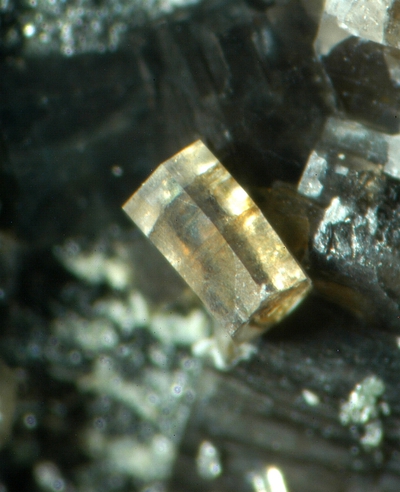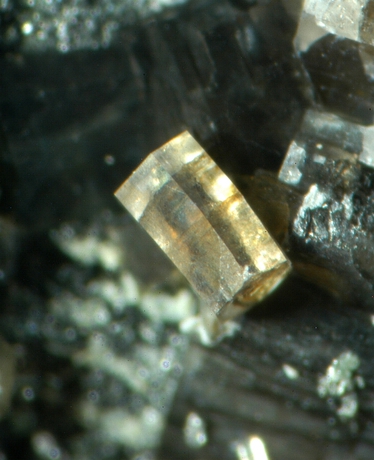Pyrosmalite-(Fe)
A valid IMA mineral species - grandfathered
This page is currently not sponsored. Click here to sponsor this page.
About Pyrosmalite-(Fe)
Formula:
Fe2+8Si6O15(OH,Cl)10
Hardness:
4½
Crystal System:
Trigonal
Member of:
Name:
Named in 1808 by Johann Friedrich Ludwig Hausmann from the Greek πυρ = fire and οσμη = smell, because of the strong odor the mineral gives off when strongly heated. Renamed by IMA with a suffix -(Fe), indicating its relationship to pyrosmalite-(Mn).
Pyrosmalite-(Fe)-Pyrosmalite-(Mn) Series.
"The mineral was originally named pyrodmalith (Hausmann 1808), then shortly after changed to pyrosmalite by Karsten (1808). History, crystallography and chemistry was discussed by Zambonini (1901, Zeitschrift für Krystallographie vol. 34, p.554-561), who remarked that all historical investigations was performed on material from Bjelke mine up until when material from Dannemora, Sweden was described by Lindström 1888. Essentially all investigations up until Zambonini displayed slight to moderate Fe > Mn, Zambonini’s own investigation on material from Nordmark confirmed this.
In the description of the new mineral manganpyrosmalite (Frondel & Bauer, 1953), it was acknowleged that six old (Fe-dominant) analyses together with the new (Mn-dominant) indicated a continuous solid solution series with Fe/(Fe+Mn) ratio from about 0.60-0.25. The old name pyrosmalite was retained for members with Fe>Mn and manganpyrosmalite was applied to members of the series with Mn>Fe.
In The iron end-member of the pyrosmalite series,from Pegmont lead-zinc deposit, Queensland, Vaughan (1986, Min. Mag. vol.50:527-531) reported an extremely iron-rich member of the series that had Fe/(Fe+Mn) ratio 0.92. Vaughan explained the nomenclature used by Frondel & Baur, and noted that the Pegmont material fell within the pyrosmalite field sensu stricto. However, Vaughan self in the article used “pyrosmalite” to designate the series and expressed an opinion that the nomenclature was unresolved. In a later short communication, Vaughan (1987, Min. Mag. vol.51:174) could report that the IMA Commission had resolved the nomenclature issue “and the Fe-rich species described in Vaughan (1986) is designated ferropyrosmalite”. This may briefly sound as Vaughan discovered a new species, when in fact he was decribing the most Fe-rich of the (Fe-rich) pyrosmalites. Thus, Vaughan was “only” enforcing a nomenclature revision, so that pyrosmalite came to designate the Fe-Mn solid solution series and the Fe vs Mn fields, came to bear names, ferropyrosmalite and manganpyrosmalite, that directly indicated the composition.
I think this is a good example of how name revisions get confounded with “new” discoveries and mineralogical history unfortunately gets erased."
(Johan Kjellman posting on Mindat forum)
"A slightly later paper by Stillwell and McAndrew (1957, Min. Mag., p. 371) also mentions Frondel and Bauer and states:
"In doing so (i.e. proposing the name manganpyrosmalite) they relegate the name pyrosmalite from that for a species as found with approximately equal amounts of Fe and Mn to that of a variety with Fe>Mn; this departure from the earlier usage is undesirable. The name pyrosmalite is here retained for all members of the isomorphous series."
(Jeffrey Vaughan, pers. comm. to Uwe Kolitsch)
The work of Yang et al. (2012) suggests the presence of disordered structural water in pyrosmalite-(Fe), consistent with infrared spectroscopic data measured from the same sample.
"The mineral was originally named pyrodmalith (Hausmann 1808), then shortly after changed to pyrosmalite by Karsten (1808). History, crystallography and chemistry was discussed by Zambonini (1901, Zeitschrift für Krystallographie vol. 34, p.554-561), who remarked that all historical investigations was performed on material from Bjelke mine up until when material from Dannemora, Sweden was described by Lindström 1888. Essentially all investigations up until Zambonini displayed slight to moderate Fe > Mn, Zambonini’s own investigation on material from Nordmark confirmed this.
In the description of the new mineral manganpyrosmalite (Frondel & Bauer, 1953), it was acknowleged that six old (Fe-dominant) analyses together with the new (Mn-dominant) indicated a continuous solid solution series with Fe/(Fe+Mn) ratio from about 0.60-0.25. The old name pyrosmalite was retained for members with Fe>Mn and manganpyrosmalite was applied to members of the series with Mn>Fe.
In The iron end-member of the pyrosmalite series,from Pegmont lead-zinc deposit, Queensland, Vaughan (1986, Min. Mag. vol.50:527-531) reported an extremely iron-rich member of the series that had Fe/(Fe+Mn) ratio 0.92. Vaughan explained the nomenclature used by Frondel & Baur, and noted that the Pegmont material fell within the pyrosmalite field sensu stricto. However, Vaughan self in the article used “pyrosmalite” to designate the series and expressed an opinion that the nomenclature was unresolved. In a later short communication, Vaughan (1987, Min. Mag. vol.51:174) could report that the IMA Commission had resolved the nomenclature issue “and the Fe-rich species described in Vaughan (1986) is designated ferropyrosmalite”. This may briefly sound as Vaughan discovered a new species, when in fact he was decribing the most Fe-rich of the (Fe-rich) pyrosmalites. Thus, Vaughan was “only” enforcing a nomenclature revision, so that pyrosmalite came to designate the Fe-Mn solid solution series and the Fe vs Mn fields, came to bear names, ferropyrosmalite and manganpyrosmalite, that directly indicated the composition.
I think this is a good example of how name revisions get confounded with “new” discoveries and mineralogical history unfortunately gets erased."
(Johan Kjellman posting on Mindat forum)
"A slightly later paper by Stillwell and McAndrew (1957, Min. Mag., p. 371) also mentions Frondel and Bauer and states:
"In doing so (i.e. proposing the name manganpyrosmalite) they relegate the name pyrosmalite from that for a species as found with approximately equal amounts of Fe and Mn to that of a variety with Fe>Mn; this departure from the earlier usage is undesirable. The name pyrosmalite is here retained for all members of the isomorphous series."
(Jeffrey Vaughan, pers. comm. to Uwe Kolitsch)
The work of Yang et al. (2012) suggests the presence of disordered structural water in pyrosmalite-(Fe), consistent with infrared spectroscopic data measured from the same sample.
Unique Identifiers
Mindat ID:
1525
Long-form identifier:
mindat:1:1:1525:3
GUID
(UUID V4):
(UUID V4):
d527cf0b-9bee-4c7f-9582-20a524c56329
IMA Classification of Pyrosmalite-(Fe)
Approved, 'Grandfathered' (first described prior to 1959)
IMA Formula:
Fe2+8Si6O15(OH)10
Classification of Pyrosmalite-(Fe)
9.EE.10
9 : SILICATES (Germanates)
E : Phyllosilicates
E : Single tetrahedral nets of 6-membered rings connected by octahedral nets or octahedral bands
9 : SILICATES (Germanates)
E : Phyllosilicates
E : Single tetrahedral nets of 6-membered rings connected by octahedral nets or octahedral bands
72.4.1a.1
72 : PHYLLOSILICATES Two-Dimensional Infinite Sheets with Other Than Six-Membered Rings
4 : Two-Dimensional Infinite Sheets with Other Than Six-Membered Rings with 4-, 6-, and 12-membered rings
72 : PHYLLOSILICATES Two-Dimensional Infinite Sheets with Other Than Six-Membered Rings
4 : Two-Dimensional Infinite Sheets with Other Than Six-Membered Rings with 4-, 6-, and 12-membered rings
17.3.12
17 : Silicates Containing other Anions
3 : Silicates with chloride (including aluminosilicates)
17 : Silicates Containing other Anions
3 : Silicates with chloride (including aluminosilicates)
Mineral Symbols
As of 2021 there are now IMA–CNMNC approved mineral symbols (abbreviations) for each mineral species, useful for tables and diagrams.
Please only use the official IMA–CNMNC symbol. Older variants are listed for historical use only.
Please only use the official IMA–CNMNC symbol. Older variants are listed for historical use only.
| Symbol | Source | Reference |
|---|---|---|
| Pys-Fe | IMA–CNMNC | Warr, L.N. (2021). IMA–CNMNC approved mineral symbols. Mineralogical Magazine, 85(3), 291-320. doi:10.1180/mgm.2021.43 |
| Pys | Warr (2020) | Warr, L.N. (2020) Recommended abbreviations for the names of clay minerals and associated phases. Clay Minerals, 55, 261–264 doi:10.1180/clm.2020.30 |
Physical Properties of Pyrosmalite-(Fe)
Hardness:
4½ on Mohs scale
Optical Data of Pyrosmalite-(Fe)
Type:
Uniaxial (-)
RI values:
nω = 1.680 nε = 1.640
Max Birefringence:
δ = 0.040

Image shows birefringence interference colour range (at 30µm thickness)
and does not take into account mineral colouration.
and does not take into account mineral colouration.
Surface Relief:
Moderate
Chemistry of Pyrosmalite-(Fe)
Mindat Formula:
Fe2+8Si6O15(OH,Cl)10
Common Impurities:
Al,Mg
Chemical Analysis
Oxide wt%:
| 1 | |
|---|---|
| SiO2 | 34.71 % |
| Al2O3 | 0.16 % |
| Fe2O3* | 4.37 % |
| FeO* | 23.80 % |
| MnO | 23.03 % |
| MgO | 1.08 % |
| CaO | 0.03 % |
| SrO | 0.01 % |
| K2O | 0.01 % |
| Cl | 2.90 % |
| H2O* | 7.94 % |
| =O-(F+Cl) | -0.65 % |
| Total: | 97.39 % |
Sample references:
Crystallography of Pyrosmalite-(Fe)
Crystal System:
Trigonal
Class (H-M):
3m (3 2/m) - Hexagonal Scalenohedral
Space Group:
P3m1
Cell Parameters:
a = 13.3165(2) Å, c = 7.0845(2) Å
Ratio:
a:c = 1 : 0.532
Unit Cell V:
1,087.98 ų (Calculated from Unit Cell)
Crystal Structure
Load
Unit Cell | Unit Cell Packed
2x2x2 | 3x3x3 | 4x4x4
Unit Cell | Unit Cell Packed
2x2x2 | 3x3x3 | 4x4x4
Show
Big Balls | Small Balls | Just Balls | Spacefill
Polyhedra Off | Si Polyhedra | All Polyhedra
Remove metal-metal sticks
Big Balls | Small Balls | Just Balls | Spacefill
Polyhedra Off | Si Polyhedra | All Polyhedra
Remove metal-metal sticks
Display Options
Black Background | White Background
Perspective On | Perspective Off
2D | Stereo | Red-Blue | Red-Cyan
Black Background | White Background
Perspective On | Perspective Off
2D | Stereo | Red-Blue | Red-Cyan
View
CIF File Best | x | y | z | a | b | c
CIF File Best | x | y | z | a | b | c
Rotation
Stop | Start
Stop | Start
Labels
Console Off | On | Grey | Yellow
Console Off | On | Grey | Yellow
Data courtesy of the American Mineralogist Crystal Structure Database. Click on an AMCSD ID to view structure
| ID | Species | Reference | Link | Year | Locality | Pressure (GPa) | Temp (K) |
|---|---|---|---|---|---|---|---|
| 0018558 | Pyrosmalite-(Fe) | Yang H, Downs R T, Yang Y W, Allen W H (2011) Pyrosmalite-(Fe), Fe8Si6O15(OH,Cl)10 Acta Crystallographica E68 i7-i8 |  | 2011 | Burguillos del Cerro, Badajos, Spain | 0 | 293 |
CIF Raw Data - click here to close
X-Ray Powder Diffraction
Image Loading
Radiation - Copper Kα
Data courtesy of RRUFF project at University of Arizona, used with permission.
Geological Environment
Paragenetic Mode(s):
| Paragenetic Mode | Earliest Age (Ga) |
|---|---|
| High-𝑇 alteration and/or metamorphism | |
| 32 : Ba/Mn/Pb/Zn deposits, including metamorphic deposits |
Type Occurrence of Pyrosmalite-(Fe)
Synonyms of Pyrosmalite-(Fe)
Other Language Names for Pyrosmalite-(Fe)
Spanish:Ferropyrosmalita
Relationship of Pyrosmalite-(Fe) to other Species
Member of:
Other Members of this group:
| Friedelite | Mn2+8Si6O15(OH,Cl)10 | Mon. 2/m : B2/m |
| Mcgillite | (Mn,Fe)8Si6O15(OH)8Cl2 | Mon. 2/m : B2/m |
| Nelenite | (Mn,Fe)16(Si12O30)(OH)14[As3+3O6(OH)3] | Trig. 3m (3 2/m) : R3m |
| Pyrosmalite-(Mn) | Mn2+8Si6O15(OH,Cl)10 | Trig. 3m (3 2/m) : P3m1 |
| Schallerite | Mn2+16As3Si12O36(OH)17 | Trig. 3m : P3m1 |
Forms a series with:
Common Associates
Associated Minerals Based on Photo Data:
| 13 photos of Pyrosmalite-(Fe) associated with Magnetite | Fe2+Fe3+2O4 |
| 5 photos of Pyrosmalite-(Fe) associated with Rhodonite | CaMn3Mn[Si5O15] |
| 3 photos of Pyrosmalite-(Fe) associated with Diopside | CaMgSi2O6 |
| 2 photos of Pyrosmalite-(Fe) associated with Chrysotile | Mg3(Si2O5)(OH)4 |
| 2 photos of Pyrosmalite-(Fe) associated with Amphibole Supergroup | AB2C5((Si,Al,Ti)8O22)(OH,F,Cl,O)2 |
| 1 photo of Pyrosmalite-(Fe) associated with Axinite-(Fe) | Ca2Fe2+Al2BSi4O15OH |
| 1 photo of Pyrosmalite-(Fe) associated with Quartz | SiO2 |
| 1 photo of Pyrosmalite-(Fe) associated with Johannsenite | CaMn2+Si2O6 |
| 1 photo of Pyrosmalite-(Fe) associated with Actinolite | ◻Ca2(Mg4.5-2.5Fe0.5-2.5)Si8O22(OH)2 |
| 1 photo of Pyrosmalite-(Fe) associated with Chalcopyrite | CuFeS2 |
Related Minerals - Strunz-mindat Grouping
| 9.EE. | Cairncrossite | Sr2Ca7-xNa2x(Si4O10)4(OH)2(H2O)15-x |
| 9.EE.05 | Bementite | Mn7Si6O15(OH)8 |
| 9.EE.07 | Innsbruckite | Mn33(Si2O5)14(OH)38 |
| 9.EE.10 | Brokenhillite | Mn8Si6O15(OH)10 |
| 9.EE.10 | Friedelite | Mn2+8Si6O15(OH,Cl)10 |
| 9.EE.10 | Pyrosmalite-(Mn) | Mn2+8Si6O15(OH,Cl)10 |
| 9.EE.10 | Mcgillite | (Mn,Fe)8Si6O15(OH)8Cl2 |
| 9.EE.15 | Nelenite | (Mn,Fe)16(Si12O30)(OH)14[As3+3O6(OH)3] |
| 9.EE.15 | Schallerite | Mn2+16As3Si12O36(OH)17 |
| 9.EE.20 | Palygorskite | ◻Al2Mg2◻2Si8O20(OH)2(H2O)4 · 4H2O |
| 9.EE.20 | Tuperssuatsiaite | Fe3+Fe3+2(Na◻)◻2Si8O20(OH)2(H2O)4 · 2H2O |
| 9.EE.20 | Yofortierite | Mn2+Mn2+2Mn2+2◻2Si8O20(OH)2(H2O)4 · 4H2O |
| 9.EE.20 | Windhoekite | Fe3+(Fe3+1.67◻0.33)Ca2◻2Si8O20(OH)2(H2O)4(OH)2 · 6H2O |
| 9.EE.20 | Unnamed (Na-Ca-Fe-Silicate-Hydrate) | NaCa(Fe2+,Al,Mn)5[Si8O19(OH)](OH)7 · 5H2O |
| 9.EE.20 | Windmountainite | ◻Fe3+2Mg2◻2Si8O20(OH)2(H2O)4 · 4H2O |
| 9.EE.25 | Falcondoite | (Ni,Mg)4Si6O15(OH)2 · 6H2O |
| 9.EE.25 | Loughlinite | Na2Mg3Si6O16 · 8H2O |
| 9.EE.25 | Sepiolite | Mg4(Si6O15)(OH)2 · 6H2O |
| 9.EE.25 | Kalifersite | (K,Na)5Fe3+7Si20O50(OH)6 · 12H2O |
| 9.EE.30 | Gyrolite | NaCa16Si23AlO60(OH)8 · 14H2O |
| 9.EE.30 | Orlymanite | Ca4Mn3Si8O20(OH)6 · 2H2O |
| 9.EE.30 | Tungusite | Ca4Fe2Si6O15(OH)6 |
| 9.EE.35 | Reyerite | (Na,K)2Ca14(Si,Al)24O58(OH)8 · 6H2O |
| 9.EE.35 | Truscottite | (Ca,Mn)14Si24O58(OH)8 · 2H2O |
| 9.EE.35 | Kodamaite | Na3(Ca5Na)Si16O36(OH)4F2 · (14-x)H2O |
| 9.EE.40 | Natrosilite | Na2Si2O5 |
| 9.EE.45 | Makatite | Na2Si4O8(OH)2 · 4H2O |
| 9.EE.50 | Varennesite | Na8Mn2Si10O25(OH,Cl)2 · 12H2O |
| 9.EE.55 | Raite | Mn2+Mn2+2Na2(◻1.75Ti0.25)Si8O20(OH)2(H2O)4 · Na(H2O)6 |
| 9.EE.60 | Intersilite | Na6Mn2+Ti[Si10O24(OH)](OH)3 · 4H2O |
| 9.EE.65 | Shafranovskite | Na3K2(Mn,Fe,Na)4[Si9(O,OH)27](OH)2 · nH2O |
| 9.EE.65 | Zakharovite | Na4Mn5Si10O24(OH)6 · 6H2O |
| 9.EE.70 | Zeophyllite | Ca13Si10O28(OH)2F8 · 6H2O |
| 9.EE.75 | Minehillite | (K,Na)2-3Ca28Zn4Al4Si40O112(OH)16 |
| 9.EE.80 | Fedorite | (Na,K)2-3(Ca4Na3)Si16O38(OH,F)2 · 3.5H2O |
| 9.EE.80 | Martinite | (Na,◻,Ca)12Ca4(Si,S,B)14B2O38(OH,Cl)2F2 · 4H2O |
| 9.EE.80 | Ellingsenite | Na5Ca6Si18O38(OH)13 · 6H2O |
| 9.EE.85 | Lalondeite | (Na,Ca)6(Ca,Na)3Si16O38(F,OH)2 · 3H2O |
Other Information
Health Risks:
No information on health risks for this material has been entered into the database. You should always treat mineral specimens with care.
Internet Links for Pyrosmalite-(Fe)
mindat.org URL:
https://www.mindat.org/min-1525.html
Please feel free to link to this page.
Please feel free to link to this page.
Search Engines:
External Links:
Mineral Dealers:
References for Pyrosmalite-(Fe)
Reference List:
Burke, Ernst A. J. (2008) Tidying up mineral names: an IMA-CNMNC scheme for suffixes, hyphens and diacritical marks. The Mineralogical Record, 39 (2) 131-135
Localities for Pyrosmalite-(Fe)
Locality List
 - This locality has map coordinates listed.
- This locality has map coordinates listed.
 - This locality has estimated coordinates.
ⓘ - Click for references and further information on this occurrence.
? - Indicates mineral may be doubtful at this locality.
- This locality has estimated coordinates.
ⓘ - Click for references and further information on this occurrence.
? - Indicates mineral may be doubtful at this locality.
 - Good crystals or important locality for species.
- Good crystals or important locality for species.
 - World class for species or very significant.
(TL) - Type Locality for a valid mineral species.
(FRL) - First Recorded Locality for everything else (eg varieties).
- World class for species or very significant.
(TL) - Type Locality for a valid mineral species.
(FRL) - First Recorded Locality for everything else (eg varieties).
All localities listed without proper references should be considered as questionable.
Argentina | |
| Milka K. de Brodtkorb (2002) |
Australia | |
| Stillwell et al. (1957) +1 other reference |
| Birch (1999) | |
| Birch (1999) |
| Vaughan (1986) |
| G. Dong & P. J. Pollard (1997) +1 other reference |
Brazil | |
| Tazava (1999) +1 other reference |
Canada | |
| Canadian Mineralogist 31 +6 other references |
| Tyson (1989) |
| Dare et al. (2014) |
| Springer (1989) +1 other reference | |
| mineral chemistry (3) +2 other references |
| Canadian Mineralogist 31 +2 other references | |
| Canadian Mineralogist 31 +2 other references |
France | |
| Pierrot et al. (1978) |
| De Ascenção Guedes et al. (2002) |
Germany | |
| Wittern (2001) |
| www.berthold-weber.de (2001) |
Japan | |
| Frank K. Mazdab collection (thin section FKM-190) |
| - (Erroneous ID) +1 other reference |
Kazakhstan | |
| Frank Dzubeck +2 other references |
Norway | |
| Knut Eldjarn specimen |
| Oftedal et al. (1965) +2 other references | |
Portugal | |
| Mineralien Atlas |
Russia | |
| ... |
| ... | |
| American Mineralogist |
Slovakia | |
| Ďuďa R. et al. (Schemnitz) |
South Africa | |
| Rocks & Minerals 83:5 pp 410-421 |
Spain | |
| Sanabria et al. (2002) |
Sweden | |
| Natural History Museum |
| Sundius et al. (1966) |
| Andersson et al. (2022) |
| Gustafsson (1992) +1 other reference |
| |
| AKMG 6 |
| Gatedal (n.d.) | |
| W. Hisinger (1815) +1 other reference |
| Geologiska Föreningen i Stockholm ... | |
| Knut Eldjarn collection - collected in ... | |
Thailand | |
| International Geological Congress (2008) |
UK | |
| Golley et al. (1995) |
| Embrey (1978) |
USA | |
| Marian Lupulescu (2008) |
Quick NavTopAbout Pyrosmalite-(Fe)Unique IdentifiersIMA Classification Classification Mineral SymbolsPhysical Properties Optical Data Chemistry Chemical AnalysisCrystallography Crystal StructureX-Ray Powder DiffractionGeological EnvironmentType Occurrence SynonymsOther LanguagesRelationshipsCommon AssociatesStrunz-MindatOther InformationInternet Links References Localities Locality List








 symbol to view information about a locality.
The
symbol to view information about a locality.
The 




Nordmark Odal Field, Filipstad, Värmland County, Sweden